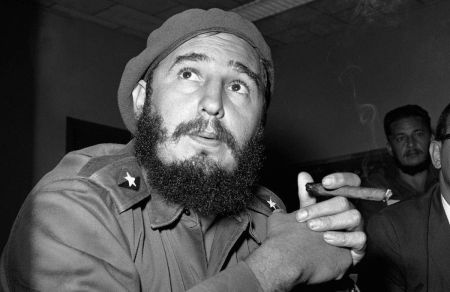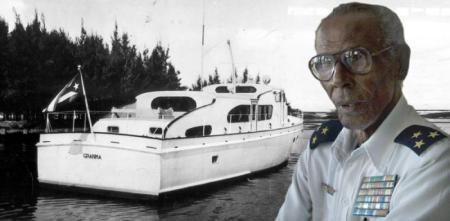PETER FROST tells a little known story from the very start of the Cuban Revolution

IT IS 1943. Working night shifts in the shipbuilding firms that make up the Brooklyn Navy Yard on New York’s East River is a young playwright called Arthur Miller below). He writes plays during the day and works nights to earn the money to live.

He is also learning the communist politics that will stay with him all his life. He learns it at meetings of the Communist Party cells among shipbuilders and longshoremen on the waterfront.
The Brooklyn Navy Yard in 1943 was a chaotic, frantically busy world of wharfs and slipways crammed with 70,000 men and women working 24 hours a day, seven days a week, building and repairing ships.

Organised gangsters are fighting to control waterfront unions using tactics like kidnap and murder against the communists and trade unionists.

One of the best and most specialist boat builders here is Wheeler Shipbuilding. Pre-war Wheelers had a fine reputation for building elegant wooden cruisers. Ernest Hemingway had his famous deep sea 38-foot angling boat Pilar built here in 1934.

Pilar was a nickname for Hemingway’s wife Pauline and also the name of the female leader of the partisan band in his 1940 novel of the Spanish civil war, For Whom the Bell Tolls. Today the Pilar is preserved at the Hemingway Museum near Havana.

When the US entered World War II after the Japanese attack on Pearl Harbour in December of 1941, Wheelers went over to building small wooden military ships based on their previous cruiser hull designs.
In 1943 they built 10 air target boats based on their pre-war 60-foot (18m) diesel-powered cabin cruisers. Navy dive bomber pilots in training would try to hit the target boats with water bombs and the boat’s crew would try to avoid being bombed.
Hull number C-1994 was no different from the other nine, but she would go on to be, in just 13 years, one of the most important vessels in the history of North America and, indeed, the world.
It is nice to think that Miller and his communist comrades may well have worked on C-1994, little realising that this tiny ship, when renamed Granma, would take Fidel Castro and his 82 Companeros to liberate the island of Cuba.

When the war finished, C-1994 was converted to a pretty and comfortable private motor yacht, fitted out to accommodate just a dozen passengers and a crew of four. Little is known of her voyages or even ownership at this time.
The yacht changed hands several times, but by 1950 the owner was Robert Erickson who made his fortune in processing lead petrol additive.
He renamed his little ship the Granma, his affectionate name for his second wife, Hazel. The Ericksons loved cruising the Gulf Coast of Mexico, including the port city of Tuxpan where they built a house overlooking the water.
When the Granma was wrecked during Tropical Storm Florence in 1954, the Ericksons seemed to lose interest in the boat. They made no effort to recover her.
In the early 1950s, after a failed attack on the Moncada army barracks, Castro and many of his comrades are imprisoned. One supporter jailed with him is navy war hero Norberto Collado. He will be key in the story of the Granma.

In May 1955, Cuban dictator Fulgencio Batista — who with the help of US-based organised crime has kept Cuba as an island of gambling clubs and brothels for rich US visitors — releases some political prisoners in an attempt to garner public sympathy. Fidel and his brother Raul are among those freed. They head to Mexico.
Collado, probably because he is black, is kept in jail and repeatedly beaten and tortured, including being burnt and hung up by his genitals. Finally he too is freed and joins Fidel and many other comrades in Mexico.
Antonio Del Conde (below) owns a gun shop in Mexico City and does a little gun smuggling on the side. He helps arm, hide, fund and train Castro’s growing rebel band. For these efforts he is excommunicated from the Catholic Church and serves time in a Texas prison.

When Del Conde passes through Tuxpan, he spots a wrecked white hull. The name on the transom is Granma.
“She was big, alone and abandoned … even though abandoned, she looked beautiful,” Del Conde wrote later.
He learns the identity of the owner and visits Erickson at his Mexico City apartment. In early 1956, Erickson agrees to sell Granma for $20,000. Del Conde plans to restore the boat over time.
Meanwhile Fidel has been planning to buy an ex-coastguard vessel or better still a Catalina flying boat, but prices are beyond his reach.
He hears about the Granma and tells Del Conde: “If you fix this boat, then on this boat I will return to Cuba.”

Castro wants to get to Cuba before the end of 1956, and he is running out of time. Del Conde has only weeks to get Granma in shape.
Refitting her is a big job. The boat needs a new keel and the diesel engines completely rebuilding. Amazingly he completes the work in about a month.
For the long voyage from Mexico to Cuba, Granma must carry enough fuel to cover more than 1,200 nautical miles. Del Conde fits new fuel tanks filling much space below deck.

As the day for departure nears, Castro tells Del Conde the latter cannot join the expedition. Castro tells his armourer that he is more useful in Mexico. By now dictator Batista is offering a $20,000 reward for Del Conde’s arrest.
As the Granma is readied for the voyage it becomes clear that she isn’t really big enough. Fidel has 140 trained fighters hidden in villages throughout the Mexican countryside. Recognising that he cannot fit them all aboard Granma, Castro settles on 81 men besides himself and even that will be a real squeeze. The rest must be left behind.
Castro appoints his old comrade Collado to serve as helmsman and on the rainy night of November 25, Collado slips the moorings and takes Granma out to sea. She is run as quietly as possible on one engine and without lights so not to alert the Mexican patrols.
Within eight hours the worn out gearbox is acting up. Granma only makes less than eight knots. The bilge pump fails and the boat takes on dangerous amounts of water. Fidel and his men bail with buckets until the pump is fixed.
After seven long and uncomfortable days the Granma reaches Cuba.
“We reached solid ground, lost, stumbling along like so many shadows or ghosts marching in response to some obscure psychic impulse,” writes Ernesto “Che” Guevara sometime later.

“We had been through seven days of constant hunger and sickness during the sea crossing, topped by three still more terrible days on land.
“Exactly 10 days after our departure from Mexico, during the early morning hours of December 5, following a night-long march interrupted by fainting and frequent rest periods, we reached a spot paradoxically known as Alegria de Pio — Rejoicing of the Pious.”
The brave little Granma had landed Castro and his Companeros in Cuba — and what follows will change history.

Since 1976, the Granma has been on permanent display in a glass enclosure at the Granma Memorial adjacent to the Museum of the Revolution in Havana.
Granma became the name of the official newspaper of the central committee of the Cuban Communist Party.
A portion of old Oriente Province, where the ship made landfall, was renamed Granma Province in honour of the vessel.
The article first appeared in the Morning Star’s 2018 Christmas Special celebrating 60 years since the liberation of Cuba.

I’ve seen the Granma a number of times — it sure doesn’t look anywhere near big enough to hold all those men and all that fuel!